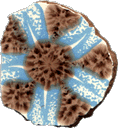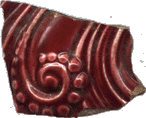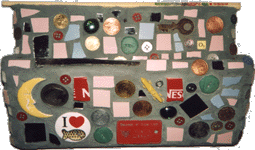Found objects and pique assiette mosaic
 The use of found objects is a central theme in pique assiette.
Found objects lend a particular richness to the work and bring
with them meaning and symbolism. On the one hand there is the
mystique, the unknown, stemming from that part of their history
that has to be guessed at. On the other hand there is the particular
story of the chance events that allowed them to be found. The
circumstances, the place, the time, all become embedded in the
object.
The use of found objects is a central theme in pique assiette.
Found objects lend a particular richness to the work and bring
with them meaning and symbolism. On the one hand there is the
mystique, the unknown, stemming from that part of their history
that has to be guessed at. On the other hand there is the particular
story of the chance events that allowed them to be found. The
circumstances, the place, the time, all become embedded in the
object.
This type of mosaic, particularly where the items are personal
ones, is sometimes referred to as "shardware" or "memoryware".
Just as hints of smells can trigger vivid memories, fragments
of the objects or patterns we have around us at different times
in our lives can be very evocative, carrying associations with
people, places, events. Also, items of sentimental value that
have been damaged beyond repair can be given a new lease of life,
using the techniques of pique assiette.
 For many, hunting for materials
is an important part of the creative experience. Found objects
are by their very nature unpredictable - charity shops, jumble
sales, car boot sales can produce treasures, while flower beds
and skips (dumpsters) may also yield gems to the eagle-eyed and
appreciative. This is something that might be called "urban
beachcombing". Whether it is a hunter-gatherer instinct
or a joyfully obsessive magpie tendency, the process of discovery
becomes part of the finished article.
For many, hunting for materials
is an important part of the creative experience. Found objects
are by their very nature unpredictable - charity shops, jumble
sales, car boot sales can produce treasures, while flower beds
and skips (dumpsters) may also yield gems to the eagle-eyed and
appreciative. This is something that might be called "urban
beachcombing". Whether it is a hunter-gatherer instinct
or a joyfully obsessive magpie tendency, the process of discovery
becomes part of the finished article.
 There are contemporary aspects that add extra meaning to pique
assiette. The current importance given to recycling means that
creative use of discarded materials has a feel-good factor attached
to it, and makes a positive statement. In addition, there's something
satisfyingly postmodern in extracting unexpected motifs from
the most horrible and uninspiring tableware. It can seem like
an act of cultural subversion to deconstruct previously popular
designs and breathe new life into them.
There are contemporary aspects that add extra meaning to pique
assiette. The current importance given to recycling means that
creative use of discarded materials has a feel-good factor attached
to it, and makes a positive statement. In addition, there's something
satisfyingly postmodern in extracting unexpected motifs from
the most horrible and uninspiring tableware. It can seem like
an act of cultural subversion to deconstruct previously popular
designs and breathe new life into them.
It is also true that domestic ceramics have many qualities that make them a material of choice for artists. The range of glazes, colours and textures can be greater than is available with other mosaic materials. Curved surfaces give reflective effects and the three dimensional nature of crockery fragments adds physical depth.
 A pique assiette mosaic can be seen
as a collage of found and prepared objects, rearranged into new
combinations. This montage approach gives wide scope for imagination
and innovation, as in any mixed media assemblage. It also generates
the humour often associated with pique assiette. As objects are
given new roles or used in unexpected ways, they make the viewer
consider everyday items in a different context.
A pique assiette mosaic can be seen
as a collage of found and prepared objects, rearranged into new
combinations. This montage approach gives wide scope for imagination
and innovation, as in any mixed media assemblage. It also generates
the humour often associated with pique assiette. As objects are
given new roles or used in unexpected ways, they make the viewer
consider everyday items in a different context.
This type of mosaic work has more levels of appreciation than might first appear, and it draws on a long history of influential examples. As a folk tradition, or a craft hobby, it is certainly art that anyone can have a share in, yet it offers scope for strong personal statements, originality, visual puns, exuberance and the happy accidents of serendipity. It can bring order to chaos, or vice versa, depending on the mood of the maker.
To round off, then, here are a few examples of mosaicists who make things from things that used to be other things...
Repsyche mosaics (Angela Casazza)
Ilana Shafir (with discussion of her method)
...not forgetting my own galleries
More about pique assiette: the history of pique assiette
The origin of the names "pique assiette" and picassiette; outsider art
the joy of shards Mosaics Resource